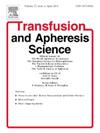Twenty years of the four-factor prothrombin complex concentrate Octaplex/Balfaxar: A narrative review
IF 1.4
4区 医学
Q4 HEMATOLOGY
引用次数: 0
Abstract
Prothrombin complex concentrate (PCC) is used to boost thrombin potential, support clot formation, and aid in the treatment and prophylaxis of bleeding. The two main forms of PCC are three-factor (3 F-PCC; comprising coagulation factors II, IX, and X) and four-factor (4F-PCC; factors II, VII, IX, X), which contain 25 times the clotting factors found in human plasma. This narrative review summarizes published efficacy and safety data on one 4F-PCC (Octaplex/Balfaxar, Octapharma) within its recognized uses and explores potential applications across different clinical contexts. Clinically available for > 20 years, Octaplex/Balfaxar is supplied as a freeze-dried powder for reconstitution and intravenous infusion. This 4F-PCC contains non-activated forms of coagulation factors as well as anticoagulant proteins C and S, potentially affording a balanced hemostatic effect and mitigating thrombosis risk. Production involves two virus inactivation/removal steps: solvent/detergent treatment and nanofiltration. 4F-PCC is approved for acquired deficiency of vitamin K-dependent clotting factors, such as those induced by vitamin K antagonists (VKAs, e.g., warfarin), and for congenital deficiency of factors II and X. Five published trials in 444 adult patients demonstrated the efficacy of 4F-PCC in VKA reversal, reducing the international normalized ratio (INR) with only two potentially treatment-related thrombotic events reported. While 4F-PCC dosing is currently indicated to be INR-guided, emerging evidence supports fixed dosing as an alternative to conventional weight-based dosing for VKA reversal. Recent guidelines support 4 F-PCC use for direct oral anticoagulant-associated bleeding, cardiac surgery and trauma/emergencies. Ongoing studies will further clarify the efficacy and safety of 4 F-PCC beyond its approved indications.
四因子凝血酶原复合物浓缩物 Octaplex/Balfaxar 推出二十年:叙述性综述
凝血酶原复合物浓缩物(PCC)用于增强凝血酶潜能、支持血块形成,以及辅助治疗和预防出血。凝血酶原浓缩物的两种主要形式是三因子(3 F-PCC,包括凝血因子 II、IX 和 X)和四因子(4F-PCC,包括凝血因子 II、VII、IX 和 X),其凝血因子含量是人体血浆中凝血因子含量的 25 倍。本综述总结了一种 4F-PCC (Octaplex/Balfaxar,Octapharma 公司)在其公认用途范围内已发表的疗效和安全性数据,并探讨了其在不同临床环境中的潜在应用。Octaplex/Balfaxar 以冻干粉的形式供应,用于复溶和静脉输注,临床应用已有 20 年之久。这种 4F-PCC 含有非活化形式的凝血因子以及抗凝蛋白 C 和 S,可提供平衡的止血效果并降低血栓形成风险。生产过程包括两个病毒灭活/去除步骤:溶剂/洗涤剂处理和纳滤。4F-PCC 已被批准用于治疗维生素 K 依赖性凝血因子后天缺乏症,如维生素 K 拮抗剂(VKA,如华法林)引起的缺乏症,以及先天性 II 和 X 因子缺乏症。5 项已发表的 444 名成年患者的试验证明,4F-PCC 在逆转 VKA、降低国际标准化比值(INR)方面具有疗效,仅报告了两例可能与治疗相关的血栓事件。虽然目前 4F-PCC 的用药剂量是以 INR 为指导的,但新的证据支持使用固定剂量替代传统的基于体重的剂量来逆转 VKA。最近的指南支持将 4F-PCC 用于直接口服抗凝剂相关出血、心脏手术和创伤/紧急情况。正在进行的研究将进一步明确 4 F-PCC 在已批准适应症之外的疗效和安全性。
本文章由计算机程序翻译,如有差异,请以英文原文为准。
求助全文
约1分钟内获得全文
求助全文
来源期刊
CiteScore
3.60
自引率
5.30%
发文量
181
审稿时长
42 days
期刊介绍:
Transfusion and Apheresis Science brings comprehensive and up-to-date information to physicians and health care professionals involved in the rapidly changing fields of transfusion medicine, hemostasis and apheresis. The journal presents original articles relating to scientific and clinical studies in the areas of immunohematology, transfusion practice, bleeding and thrombotic disorders and both therapeutic and donor apheresis including hematopoietic stem cells. Topics covered include the collection and processing of blood, compatibility testing and guidelines for the use of blood products, as well as screening for and transmission of blood-borne diseases. All areas of apheresis - therapeutic and collection - are also addressed. We would like to specifically encourage allied health professionals in this area to submit manuscripts that relate to improved patient and donor care, technical aspects and educational issues.
Transfusion and Apheresis Science features a "Theme" section which includes, in each issue, a group of papers designed to review a specific topic of current importance in transfusion and hemostasis for the discussion of topical issues specific to apheresis and focuses on the operators'' viewpoint. Another section is "What''s Happening" which provides informal reporting of activities in the field. In addition, brief case reports and Letters to the Editor, as well as reviews of meetings and events of general interest, and a listing of recent patents make the journal a complete source of information for practitioners of transfusion, hemostasis and apheresis science. Immediate dissemination of important information is ensured by the commitment of Transfusion and Apheresis Science to rapid publication of both symposia and submitted papers.

 求助内容:
求助内容: 应助结果提醒方式:
应助结果提醒方式:


